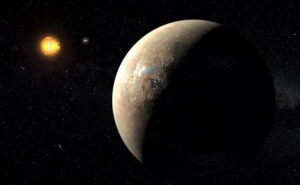What would be the price for something to go To The Moon
Inspired by @dragosroua article:
How Long It Will Take To STEEM To Go To The Moon?
Looks like the distance to the Moon is exactly 384,400 km. A lot, right?
So, what if 1 km would be equal 1 cent? Just so, you know, to have something to compare with.
In this case, I think we can acknowledge STEEM as being on the Moon if the total value of STEEM is 1 cent x 384,400 km, right.
384,400 x 0.01 = 3,844 USD. <- Moon stage
At first glance, this seems like a good measurement. And, I wouldn’t have thought about changing it, if I hadn’t been tracking some coins that John McAffee said would do better than his $1,000,000 for BitCoin by the end of 2020. I decided, I would have to figure out what the value of beyond The Moon is for John’s prediction.
Granted, John initially bet USD$500,000 and then doubled down to say USD$1,000,000 by the end of 2020. His comment on the other coins is that in 3-5 years (or, up to 3 years after BitCoin hits $1 million) that these coins would surpass that value for BitCoin.
So, while I can calculate what is “To The Moon” for these coins, I would also have to figure how far these other coins are going to go.
To The Moon Calculated 🚀
The first problem I ran into is comparing the coins to each other. Since, I have stated in my What a Little Steem Will Do – Update for January 2017 that BitCoin(BTC) is the measure for how well I am doing in trading, I am going to stick with that as the measure of what is “To The Moon” or “To the Sun“.
Next was to get a logical measurement to break things down.
@dragosroua used 1 km == 0.01
When I tried to do some calculations that would match up to the real world based on BitCoin, that didn’t work. The logical measurement would have to use 0.00000001 or 1 Satoshi.
Dividing 1 Satoshi into the distance of the Moon (384,400 km) gave an interesting number.
384,400 x 0.00000001 = 0.003844
Mar 2010 $0.003 — On 17 Mar 2010, the now-defunct BitcoinMarket.com exchange is the first one that starts operating.
With BitCoin, “The Moon“, was actually The Start of trading of BitCoin.
Alas, I couldn’t use the distance to the Moon.
Since I provide the Near-Earth Object(NEO) tracker information in my Space Weather Daily Update, I use AU as the measurement of how far off the NEO is from Earth when it passes.
The astronomical unit (symbol: au or ua) is a unit of length, roughly the distance from Earth to the Sun. Approximately 150,000,000,000,000 km.
If I divide 1 Satoshi into 1 AU, I get a real number that makes sense.
150,000,000,000,000 x 0.00000001 = 1,500,000 or 1 sAU (Satoshi Astronomical Unit)
$1,500,000 is what the price of BitCoin will be at the end of 2019 if it keeps increasing by around 1000%, which is an easy average year-over-year increase for BitCoin. And, it is close to John’s double down bet of $1,000,000. Plus, an easy number to work with in my calculations.
Can BitCoin Hit $1,000,000 by July 2020?
Now, getting The Moon number is a little more tricky, so I just decided to pick an arbitrary point of 1%.
If you are at the Moon, you are just taking the 1st step in exploring the Solar System. So, you only have gone 1% of the way. When I take 1% of 150,000,000,000,000 x 0.00000001, I get $15,000.
1 sAU x .01 = 15,000
Well, $15,000 did feel like a breaking point number for BitCoin as it shot up towards its peak of $20,000.
So, now I have my base numbers for BitCoin to The Moon and The Sun.
But, we need to point out that cryptocurrencies have different coin amounts, which affects Market Capitalization and price. And because of that, we need to show the difference between that coin and BitCoin. BitCoin has a maximum number of coins of 21,000,000. For each coin compared, we would need to divide the number of BitCoins into that coin to get our “deMultiplier”. Basically the divider. I call it the deMultiplier, because most coins have much more coins than BitCoin will ever have, so they will go to The Moon at a lower price level and possibly will never see the high prices that BitCoin does.
To The Moon Results 🚀🚀
I’ve included the top alt coins, John’s Top 5 and one of my Hodl coins, Cardano as examples.
| Coin | Max Supply* | deMultiplier | Moon (USD) | Sun (USD) |
|---|---|---|---|---|
| BitCoin(BTC) | 21,000,000 | 1 | $15,000 | $1,500,000 |
| Ethereum(ETH)* | 97,143,814 | 4.34 | $3,456 | $345,622 |
| Ripple(XRP) | 100,000,000,000 | 4,762 | $3.15 | $314.99 |
| Litecoin(LTC) | 84,000,000 | 4 | $3,750 | $375,000 |
| Verge(XVG)† | 16,555,000,000 | 788.3 | $19.03 | $1,902.83 |
| DigiByte(DGB)† | 21,000,000,000 | 1,000 | $15 | $1,500 |
| ZenCash(ZEN)† | 21,000,000 | 1 | $15,000 | $1,500,000 |
| Monero(XMR)*† | 15,632,991 | 0.74 | $20,2707 | $2,027,027 |
| Steem(STEEM)* | 264,437,764 | 12.59 | $1,191.42 | $119,142 |
| Steem Dollars(SBD)* | 6,797,421 | 1.47 | $22,050 | $1,020,408 |
| Cardano(ADA) | 45,000,000,000 | 2,100 | $7.143 | $714.29 |
* if known, else using circulating supply
† John "I'll Eat My Dick" McAfee" Shoot for the Sun Top Coins
Beyond The Sun 🚀🚀🚀
Since John said that these coins were going beyond $1 million, it is time to figure out where they will be. We just need to figure out how may sAU they will be when they hit $1 million. We just take the Sun sAU price and divide into $1 million and then multiply it by 10,000,000 to get the kilometer distance.
| coin | Sun | Beyond sAU |
|---|---|---|
| Verge(XVG) | 1,902.83 | 525.76 |
| DigiByte(DGB) | 1,500 | 667 |
| ZenCash(ZEN) | 1,500,000 | .67 |
| Monero(XMR) | 2,027,027.027 | .49 |
Verge and DigiByte will be 5,257,600,000 km into space, which is some where past Neptune.
While ZenCash and Monero will be somewhere between the Earth and Mars.
Now you can figure out where your coin has to be in order to be To The Moon!
This article was also posted on my Steemit.com blog.
About DeanLogic
Dean has been playing around with programming ever since his family got an IBM PC back in the early 80's. Things have changed since BASICA and Dean has dabbled in HTML, JavaScript, Action Script, Flex, Flash, PHP, C#, C++, J2ME and SQL. On this site Dean likes to share his adventures in coding. And since programming isn't enough of a time killer, Dean has also picked up the hobby of short film creation.


